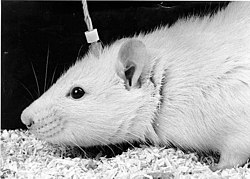
Remote control animals are animals that are controlled remotely by humans. Some applications require electrodes to be implanted in the animal's nervous system connected to a receiver which is usually carried on the animal's back. The animals are controlled by the use of radio signals. The electrodes do not move the animal directly, as if controlling a robot; rather, they signal a direction or action desired by the human operator and then stimulate the animal's reward centres if the animal complies. These are sometimes called bio-robots or robo-animals. They can be considered to be cyborgs as they combine electronic devices with an organic life form and hence are sometimes also called cyborg-animals or cyborg-insects.
Because of the surgery required, and the moral and ethical issues involved, there has been criticism aimed at the use of remote control animals, especially regarding animal welfare and animal rights, especially when relatively intelligent complex animals are used. Non-invasive applications may include stimulation of the brain with ultrasound to control the animal. Some applications (used primarily for dogs) use vibrations or sound to control the movements of the animals.
Several species of animals have been successfully controlled remotely. These include moths,[1][2] beetles,[3] cockroaches,[4][5][6] rats,[7] dogfish sharks,[8] mice[9] and pigeons.[9]
Remote control animals can be directed and used as working animals for search and rescue operations, covert reconnaissance, data-gathering in hazardous areas, or various other uses.
- ^ "Nerve probe controls cyborg moth in flight". New Scientist. Retrieved 12 November 2022.
- ^ Tsang, W.M.; Stone, Alice L.; Otten, David; Aldworth, Zane N.; Daniel, Tom L.; Hildebrand, John G.; Levine, Richard B.; Voldman, Joel (March 2012). "Insect-machine interface: A carbon nanotube-enhanced flexible neural probe". Journal of Neuroscience Methods. 204 (2): 355–365. doi:10.1016/j.jneumeth.2011.11.026. PMID 22155384. S2CID 7775080.
- ^ Callaway, Ewan (1 October 2009). "Free-flying cyborg insects steered from a distance". New Scientist. Retrieved 9 November 2013.
- ^ "Row over US mobile phone 'cockroach backpack' app". BBC News. 9 November 2013. Retrieved 9 November 2013.
- ^ Cite error: The named reference
AP 10-01-97was invoked but never defined (see the help page). - ^ Cite error: The named reference
10.1038/s41528-022-00207-2was invoked but never defined (see the help page). - ^ Harder, Ben (1 May 2002). "Scientists "Drive" rats by remote control". National Geographic. Archived from the original on 9 June 2002. Retrieved 9 November 2013.
- ^ Hatch, Cory (2005). "Sharks: Ocean spies of the future?". triplepoint. Retrieved 9 November 2013.
- ^ a b "Chinese scientists experiment with remote control of animals". People. 27 February 2007. Retrieved 9 November 2013.